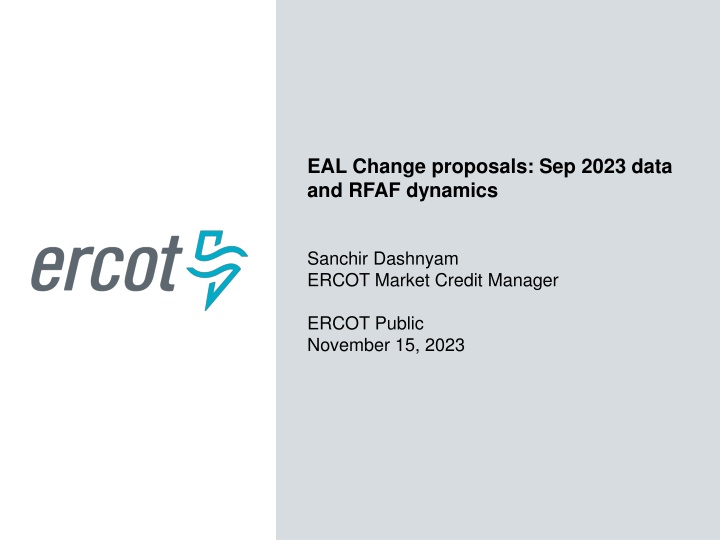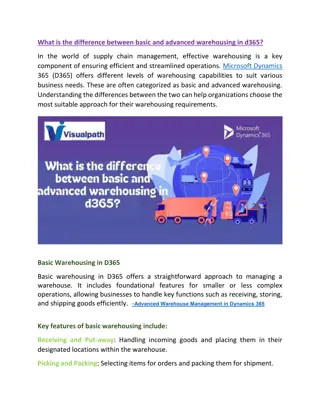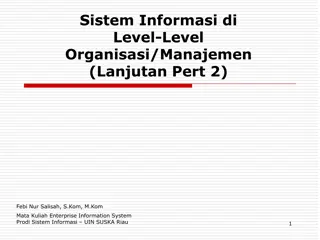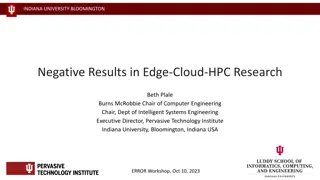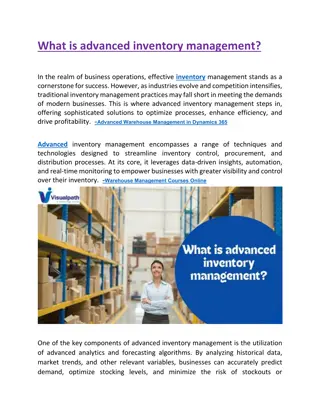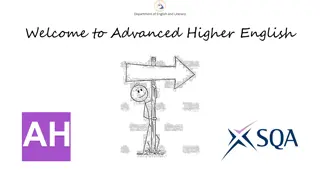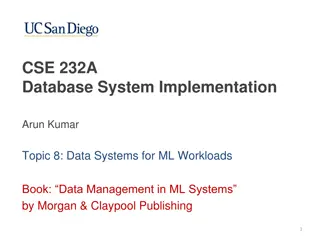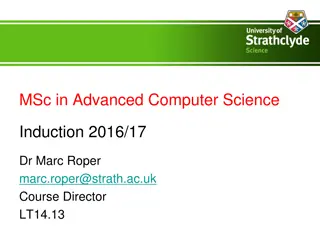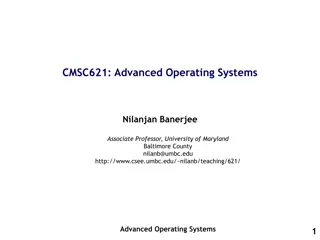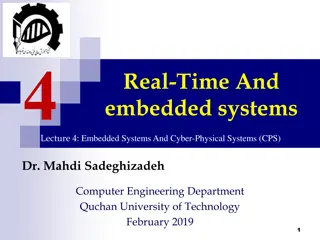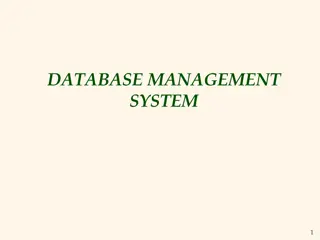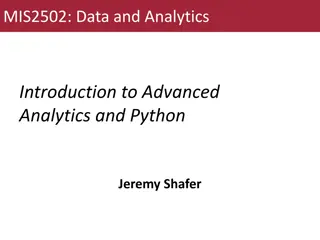Advanced Systems Research Overview
This course delves into cutting-edge computer systems research, covering classic insights, fundamental theories, and new topics exciting researchers today. Participants are required to attend all classes, engage in readings, and complete projects. The focus is on gaining a deep understanding of systems research attributes and presenting findings effectively.
Download Presentation

Please find below an Image/Link to download the presentation.
The content on the website is provided AS IS for your information and personal use only. It may not be sold, licensed, or shared on other websites without obtaining consent from the author.If you encounter any issues during the download, it is possible that the publisher has removed the file from their server.
You are allowed to download the files provided on this website for personal or commercial use, subject to the condition that they are used lawfully. All files are the property of their respective owners.
The content on the website is provided AS IS for your information and personal use only. It may not be sold, licensed, or shared on other websites without obtaining consent from the author.
E N D
Presentation Transcript
EAL Change proposals: Sep 2023 data and RFAF dynamics Sanchir Dashnyam ERCOT Market Credit Manager ERCOT Public November 15, 2023
Invoice exposures definition Invoice exposures Old Invoice exposure is defined as Invoices * M1 days + RTLCNS + UDAA . Invoices include charges only. Invoice exposures New M1 days forward invoices + 7 days look back actual invoices M1 days could range from 10 to 21 days depending on weekends/holidays, MP activity Invoices exclude M&N securitization invoices, CRR auction invoices and miscellaneous invoices relating to $2B distributed to market for Sec N on 6/21/22 Data is for a period covering 1/1/22 through 8/30/23 TPEA excludes Uri invoices and PUL uplift TPEA Invoice exposures = Gap Negative gap is when invoice exposures exceed TPEA (less than -$10,000) Positive gap is when TPEA exceeds invoice exposures (more than $10,000) 2 ERCOT Public
Current EAL Formula vs. Scenarios #2 and #3 Current: EAL q = Max [IEL during the first 40-day period only beginning on the date that the Counter-Party commences activity in ERCOT markets, RFAF * Max {RTLE during the previous lrq days}, RTLF] + DFAF * DALE + Max [RTLCNS, Max {URTA during the previous lrq days}] + OUT q + ILEq Scenario #2: EAL q = Max [IEL during the first 40-day period only beginning on the date that the Counter-Party commences activity in ERCOT markets, Max{(RFAF * Max {RTLE) during the previous lrq days}, RTLF] + DFAF * DALE + Max [RTLCNS, Max {URTA during the previous lrq days}] + OUT q + ILE q Scenario #3: EAL q = Max [IEL during the first 40-day period only beginning on the date that the Counter-Party commences activity in ERCOT markets, RFAF * Max {RTLE during the previous lrq days}, RTLF] + DFAF * DALE + Max [RTLCNS, Max {URTA during the previous lrq days}] + OUT q + ILE q Two RFAF s: CP specific RFAF and Global RFAF CP specific RFAF = Projected Real-Time ICE Forward Average Price / Max RTLE date Historic Real- Time Settled Average Price Global RFAF is calculated based on existing methodology. Global RFAF is used in MCE calculations. 3 ERCOT Public
TPEA vs Invoice Exposures incl. Sep: market, load & gen, load 4 ERCOT Public
RFAF RFAF 12.00 11.00 2/12/2021, 10.61 10.00 9.00 8.00 7.00 7/14/2023, 6.09 6.00 2/1/2022, 5.37 8/9/2023, 5.33 5.00 4.00 3.00 2.00 1.00 7/26/2022, 0.64 3/15/2022, 0.62 7/9/2023, 0.62 1/11/2023, 0.52 9/12/2023, 0.17 2/24/2021, 0.01 0.00 RFAF RFAF by its definition is very volatile: RFAF peaked during winter storm Uri at almost 11 then went to 0.01 on 2/24/21. Most recently it hit 6 in July 2023, which was the highest since Feb 2021. Also, it went as low as 0.15 on 9/13/23, which was the lowest since Uri. The fact that, RFAF goes down below 1 means TPE is essentially mechanically lowered once historical settled prices roll off from the denominator. 5 ERCOT Public
RFAF vs Avg settled prices RFAF vs Avg Settled prices 7.00 $1,200 6.00 $1,000 5.00 $800 4.00 $600 3.00 $400 2.00 $200 1.00 $0 0.00 -$200 RFAF AVG_PRICE_ALL RFAF does not always predict the magnitude or extent of price volatility. In 2023 prices were sustained at high levels throughout the summer, whereas in 2022 there was a relatively short period of high prices at the end of July. On the other hand, RFAF before July 22 price spike peaked at roughly 2.5, while it hit 6 in July 23 with relatively low prices. Spike in July 23 was rather a mechanical increase compared to the second spike in August 23, which was more on point . RFAF was essentially below 1 for the entire month of September 2023. After August 9th peak of 5.3 RFAF has declined steadily and bottomed in mid September despite prices being relatively high during 9/6-9/10. A market participant would have been exposed to higher prices, while TPEA would have been artificially lowered due to the RFAF going below 1. Also, it is noted that in cases of MCE driving TPEA, RFAF going below 1 could also artificially depress TPEA. 6 ERCOT Public
Example, a load & gen MP during September 2023 Scenario #2 looks at Max (RFAF *RTLE during the previous lrq days), thus, it does solve the problem of RFAF going below 1 and artificially depressing exposures. On the other hand, the TPEA under Scenario #2 will tend to sit there until the Max rolls off. Current methodology and Scenario #3, could result in negative gap events, especially, when RFAF goes below 1. $120,000,000 $100,000,000 $80,000,000 $60,000,000 $40,000,000 $20,000,000 $0 CPTPEA_C CPTPEA_S2 CPTPEA_S3 New_Prop_Invoice_Exposure 7 ERCOT Public
June through Sep 2023: Negative and positive gaps Negative Gap Current S2 S3 Sum total (10,234,603,966) $ (8,332,807,652) $ (12,640,661,667) $ Compared to Current# of occurences Compared to Current -18.6% 23.5% Average (3,495,425) $ (3,127,931) $ (4,033,396) $ Compared to Current 2,928 2,664 3,134 -9.0% 7.0% -10.5% 15.4% Positive Gap Current S2 S3 Sum total 236,074,358,078 $ 253,565,079,859 $ 192,005,321,847 $ Compared to Current# of occurences Compared to Current 7.4% -18.7% Average 5,897,141 $ 6,283,362 $ 4,829,958 $ Compared to Current 40,032 40,355 39,753 0.8% -0.7% 6.5% -18.1% Negative gaps Scenario #2 lowers negative gaps while Scenario #3 increases negative gaps Scenario #2 reduces negative gap occurrences by 9%, aggregate total negative gap amounts by 18.6% with the average negative gap amounts decreasing 10.5%. Scenario #3 increases negative gap occurrences by 7%, aggregate total negative gap amounts by 23.5% with the average negative gap amount increasing by 15%. Positive gaps Scenario #3 will lower positive gaps while Scenario #2 will increase them Scenario #2 increases positive gap occurrences by 0.8%, increases aggregate total positive gap amounts by7.4% with the average positive gap amount staying about the same. Scenario #3 reduces positive gap occurrences by 0.8%, aggregate total positive gap amounts by 18.7% with the average positive gap amount decreasing 18.1. 8 ERCOT Public
Top 20 negative gap counterparties, current 9 ERCOT Public
Correlation: Invoice exposures vs Current, Scenario #2 and Scenario #3 CORRELATION ANALYSIS New_Prop_Invoice_Exposure CPTPEA_C CPTPEA_S2 CPTPEA_S3 Top20 Whole Year (Jan'22 - Sep-23) Top20 Summer (Jun-Sep) Top20 Winter (Dec-Feb) Top20 Shoulder (Oct-Nov) Load Gen Load & Gen Trader 0.697 0.676 0.522 0.702 0.763 (0.004) 0.450 0.250 0.763 0.747 0.668 0.691 0.807 0.030 0.462 0.282 0.809 0.802 0.667 0.678 0.867 0.006 0.508 0.286 As much as the correlation coefficient is closer to +1 or -1, it indicates positive (+1) or negative (-1) correlation between the arrays. Positive correlation means that if the values in one array are increasing, the values in the other array increase as well. A correlation coefficient that is closer to 0, indicates no or weak correlation. are the sample means AVERAGE(array1) and AVERAGE(array2) Both scenarios appear to have higher correlation with invoice exposures compared to the existing methodology. Scenario #3 appears to have a highest correlation with invoice exposures, though the marginal difference compared to Scenario #2 appears to not that significant. Scenario #2 lowers negative gaps while Scenario #3 increases negative gaps. Scenario #3 lowers the positive gaps the most. 10 ERCOT Public
